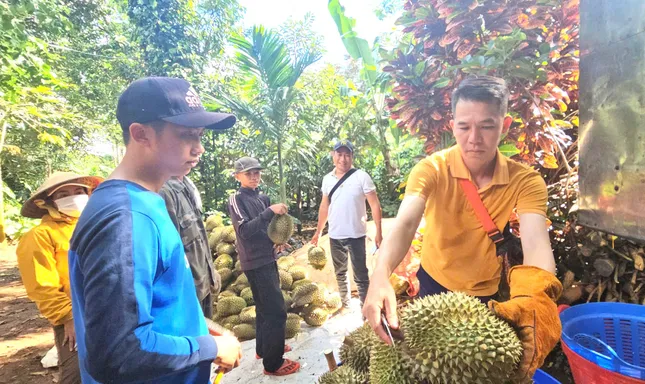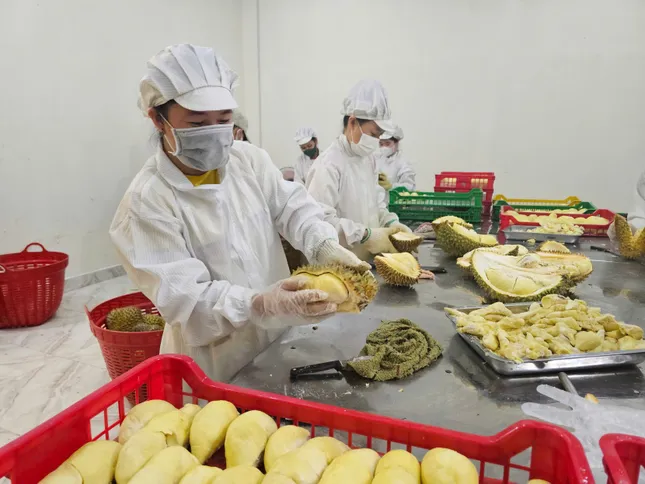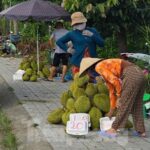According to statistics from the Dak Lak Department of Agriculture and Environment, the province leads the country with 38,800 hectares of durian plantations.
The durian orchards in the province are currently in the fruit-bearing stage, and harvest is expected to begin in about three months. The estimated yield for the province in 2025 is approximately 400,000 tons, a significant increase of 100,000 tons from the previous year.
However, this year’s harvest faces challenges in terms of export to China, the primary market for durian from Dak Lak and Vietnam as a whole. China has tightened plant quarantine regulations on each shipment, impacting the durian export situation.
This tightening of regulations has led to a significant decline in durian exports in the first half of this year. Many shipments to China have been returned due to Cadmium and Yellow O contamination, causing a sharp drop in durian prices compared to the same period in 2024. In some areas, durian prices have fallen by 40-50%.

Dak Lak province is three months away from the durian harvest season.
Farmers like Mr. Pham Van Dai, a durian grower in Cu Pong commune, Krong Buk district, are concerned about the output for their produce as China tightens its quarantine measures for prohibited substances, causing delays in orders and a significant drop in prices.
“We can follow any production process as long as we are guided accordingly. My main concern is to have a guaranteed output at a fair price. Input costs have risen significantly, and I hope the authorities will come up with decisive solutions for the upcoming harvest,” said Mr. Dai.
Mr. Nguyen Duc Dien, Director of Thien Phu Agricultural Services Cooperative in Cu Pong commune, shared that the cooperative has a total durian area of over 77 hectares with 44 members. Recently, the cooperative was granted three planting codes, which the farmers have long awaited to officially partner with enterprises for exporting their products.
“The cooperative wishes to collaborate with reputable enterprises to ensure stable output. This way, we can focus on cultivating delicious and high-quality durians, while the enterprises will handle the output, ensuring that products from the planting area meet the standards for export,” Mr. Dien expressed.

For the sustainable development of the durian industry, there is a need to invest in deep processing and product diversification.
Mr. Nguyen Van Ha, Deputy Director of the Dak Lak Department of Agriculture and Environment, emphasized the necessity of building a value chain for durian. The department has directed the Agriculture Department to implement a “say no to prohibited substances” program. The locality aims to ensure that no shipments are returned by China due to Cadmium and Yellow O contamination in the upcoming season.
The department is working with the Dak Lak Durian Association to establish 10-15 commodity chains involving reputable enterprises with packaging facilities and cooperatives with planting codes. Together, they will organize production to meet the set standards, with the participation of scientists and local authorities.
A special task force will be formed to work with enterprises, cooperatives, local authorities, and scientists to prevent prohibited substances and conduct joint sampling inspections. The information will be made transparent to partners, and pre-harvest inspections will be carried out to ensure a 99% safety rate for the shipments.
The Plummeting Exports of Fruits and Vegetables: A Troubling Trend
“The Vietnamese fruit and vegetable industry experienced a significant downturn in the first five months of the year compared to the same period last year, according to Dang Phuc Nguyen, Secretary-General of the Vietnam Fruit and Vegetable Association (Vinafruit). This slump is a result of compounded market factors, casting doubt on the sector’s ability to meet its annual export targets.”
Unlocking New Opportunities for Vietnamese Durian in the Chinese Market
The king of fruits, durian, is set to conquer new territories as Vietnam’s durians gain traction in the massive Chinese market. With nearly 1,000 approved codes, the fragrant and flavorful Vietnamese durians are now poised to tantalize the taste buds of Chinese consumers, presenting a golden opportunity for the country’s farmers and exporters alike.
“Plunging Prices and Failed Exports: Are Durian Farmers Facing a Nightmare?”
The durian prices in the Mekong Delta have taken a significant dip as the region enters its peak harvest season. With exports to the Chinese market facing challenges, durian farmers are left hoping for better fortunes in the upcoming seasons. The profits this year are a mere fraction, a quarter to be precise, of what they were when the prices were at their peak. Despite this setback, the ‘billion-dollar fruit’ still holds allure for farmers, who remain optimistic about durian’s potential in the future.





















